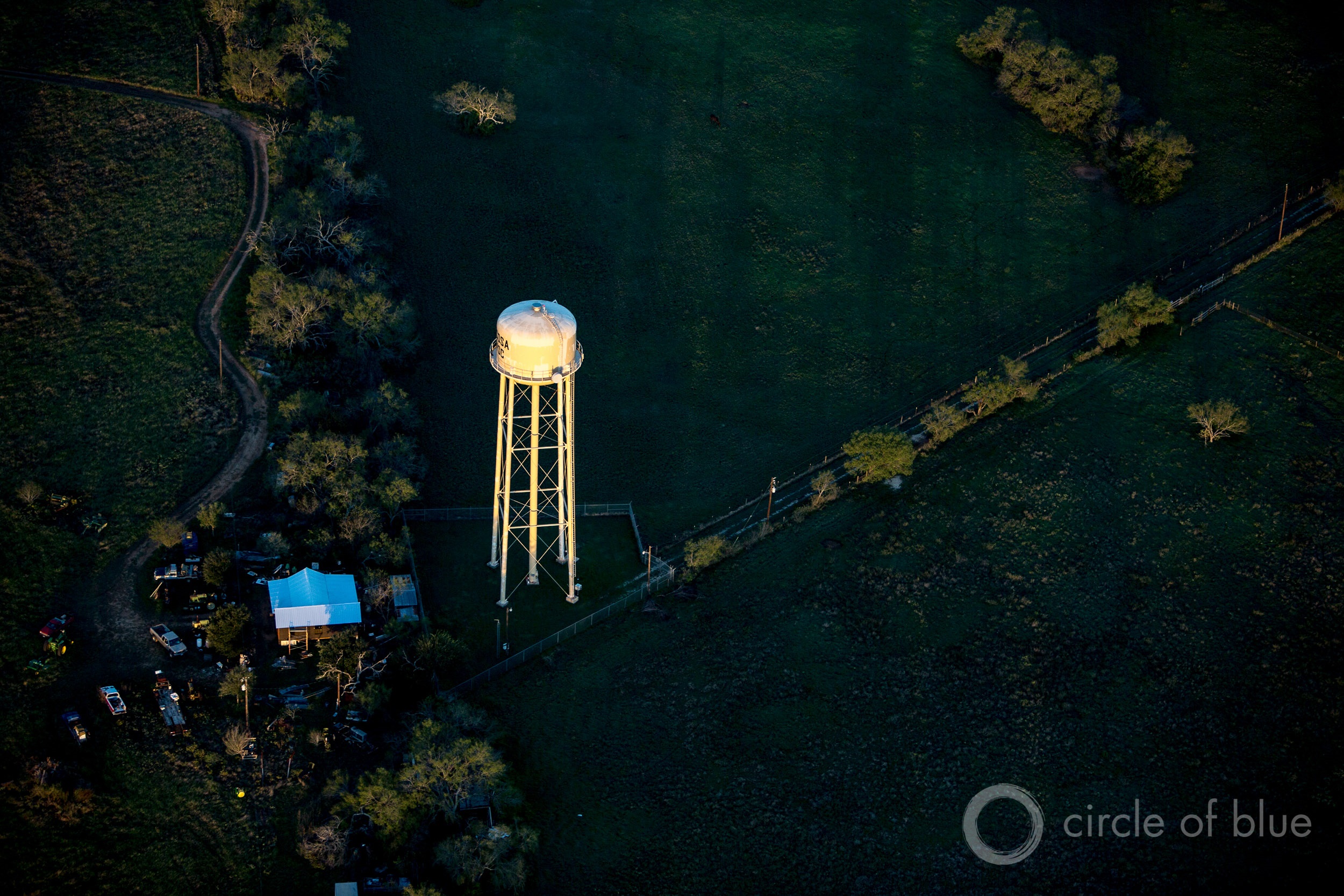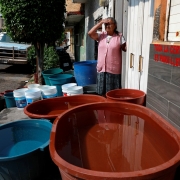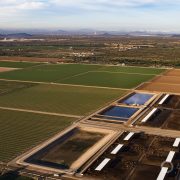After Flint Failure, EPA Refocuses Federal Drinking Water Role
Agency notes that safe water is a communal effort.

A water tower rises above a town near San Antonio, Texas. Photo © J. Carl Ganter / Circle of Blue
By Brett Walton, Circle of Blue
The lead contamination scandal that unraveled in Flint the last two years and the failure of local, state, and federal officials to address it brought drinking water safety to the forefront of U.S. public policy.
For good reason. Twenty-seven million American residents — nearly 9 percent of the country’s population — are served by utilities that violate at least one federal drinking water standard. Millions more drink water from unregulated household wells that are contaminated by nitrate, arsenic, or one of a host of industrial chemicals.
Though public health authorities assert that America’s drinking water, broadly speaking, is first-rate, water that serves certain poorer cities, rural communities, or pregnant women and infants is an undeniable health hazard.
Determining what to do about it was the intent of a U.S. Environmental Protection Agency review of the nation’s drinking water strategy that began in May. On November 30, the agency published the results of its introspection, a 33-page “action plan” aimed at preventing a deepening divide between clean water haves and have-nots. The plan’s formula, expressed in six priority areas and dozens of recommended actions, is a combination of 21st century technology, old-fashioned government collaboration, stronger oversight, and a can-do spirit.
“As a country, we can and must do more to make sure that every American has access to safe drinking water,” said Joel Beauvais, head of the U.S. Environmental Protection Agency Office of Water.
The action plan’s priority areas include:
- Assist poor, rural, and minority communities that lack funding or technical expertise.
- Use data and periodic performance reviews to track and improve state and local oversight.
- Prevent pollution of rivers, lakes, and aquifers so that source waters are cleaner.
- Understand and prioritize the risks from unregulated contaminants.
- Improve public communication about drinking water safety.
- Reduce the incidence of lead poisoning by revising the federal Lead and Copper Rule.
Obstacles to success are around every corner. Old pipes require billions in new investment at the same time that water affordability is becoming a primary concern, especially in older cities in the Midwest and New England. Oversight is handcuffed by stagnant state and federal budgets and regulators more interested in completing a checklist than exercising a firm hand. Rivers, lakes, and aquifers are polluted by farm nutrients and industrial waste before they arrive at the treatment plant, raising costs. Unregulated contaminants, from pharmaceutical hormones to pesticides, pose an unquantified health risk. And in the background, climate change exposes brittle systems to powerful droughts and floods.
A Path to Clean Water
Several recommendations in the plan stand out. One is to consolidate small systems or expand regional partnerships. There are more than 50,000 community water systems in the United States — those that serve a city, town, trailer park, or subdivision year-round. More than half of these systems serve fewer than 500 people.
Maintaining and staffing a vast, distributed set of small water networks is more expensive than operating fewer larger units. That is why the movement to merge systems is gaining momentum.
“I agree absolutely,” Lynn Thorp, national campaigns director for Clean Water Action, an advocacy group, told Circle of Blue. “The sheer number of systems and the expectation of sophistication — in treatment and in asset management — is a huge challenge for small systems.”
Some states are already making progress in this area. California, for instance, passed a law in June 2015 that allows the state water board to force a larger system to absorb a smaller neighbor if the neighbor fails to provide clean water. The board has ordered one consolidation and is pursuing six more.
Physical connections are not the only remedy. Small systems could combine operations by sharing staff, outsourcing billing, or reaching out to nearby cities for technical expertise.
Partnerships are “a really important area,” Peter Grevatt, director of the EPA groundwater and drinking water program, told the National Drinking Water Advisory Council on December 6. Grevatt said that he did not expect a federal mandate to consolidate systems. Instead, the agency is looking at ways to support utilities that choose to do so, and will host a meeting on partnerships on January 31, 2017, in Washington, D.C.
There are, of course, social and political hurdles to work out: rivalries between utilities, turf battles, loss of local control, and whether a larger system would inherit drinking water violations brought against the smaller system.
A second item of interest is a focus on technology, which the Obama administration has repeatedly emphasized in its approach to water issues. The EPA action plan is accompanied by a report from the President’s Council of Advisers on Science and Technology that describes the role of water treatment gadgets and water monitoring gizmos. Both the EPA and the council foresee growth in the use of water quality sensors, data analysis, leak detection equipment, and purification processes that more effectively remove contaminants.
“When taken together these efforts could be transformative for the drinking water industry, which is also the case for developing the next generation of technologies to improve safety of drinking water,” Elin Betanzo, a water policy analyst at the Northeast-Midwest Institute, told Circle of Blue.
The third area is collaboration between agencies and coordination of policies. Most states are the primary enforcer of the Safe Drinking Water Act. An unwillingness by the EPA to interfere with Michigan regulators resulted in seven months delay before intervening in Flint.
On the policy side, both Thorp and Betanzo said that clean water regulations and drinking water regulations should be more closely aligned. Treating water, after all, is easier when it is clean at the start.
“There’s a lot of pollution left on the table,” Thorp explained, referring to exemptions in the Clean Water Act for agriculture and the thousands of unregulated contaminants. “There’s a de facto reliance on public water systems to meet the public expectation of zero-risk water. They are bearing a burden that needs to be addressed upstream.”
Though widely praised for its comprehensive view, the plan faces deep uncertainty with the presidential transition, argues Alan Roberson, director of policy at Corona Environmental Consulting and former director of federal relations at the American Water Works Association. “What’s going to happen with this in a Trump administration?” Roberson wonders. “How much of it is going to move forward? It’s a huge question mark for everyone I’ve talked to. I don’t have an answer.”
Brett writes about agriculture, energy, infrastructure, and the politics and economics of water in the United States. He also writes the Federal Water Tap, Circle of Blue’s weekly digest of U.S. government water news. He is the winner of two Society of Environmental Journalists reporting awards, one of the top honors in American environmental journalism: first place for explanatory reporting for a series on septic system pollution in the United States(2016) and third place for beat reporting in a small market (2014). He received the Sierra Club’s Distinguished Service Award in 2018. Brett lives in Seattle, where he hikes the mountains and bakes pies. Contact Brett Walton









